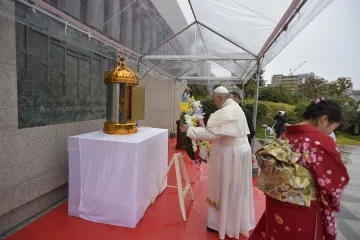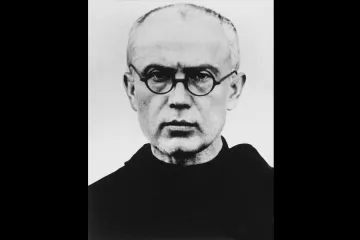Washington, D.C. Newsroom, Aug 9, 2024 / 05:00 am
When the American military dropped an atomic bomb on Nagasaki, Japan, on Aug. 9, 1945, the city was completely devastated — more than 40,000 people were instantly killed by the blast as well as about 60,000 more in the following five years as a result of radiation-related diseases.
Everything within a mile and a half of the plutonium bomb’s hypocenter was destroyed, including 14,000 homes and the Urakami Cathedral, where the faithful had gathered that morning for Mass in preparation for the feast of the Assumption of the Blessed Virgin Mary shortly before “Fat Man” was detonated.
While the bombing devastated both the city of Nagasaki and its large Catholic population, the monastery of Seibo no Kishi located in the mountains on the outskirts of Nagasaki was spared.
A Franciscan monastery built by Father Maximilian Kolbe and his supporters in 1931, this spot served as the second location for Kolbe’s “City of the Immaculata” mission that had started with his Niepokalanów monastery in Tersein, Poland.
Maximilian Kolbe’s missionary work in Japan
Kolbe was determined to expand foreign missionary work to Japan, even after having launched the monthly magazine Knight of the Immaculata in Kraków in 1922. He approached Father Alfonso Orlini, the father general of the Conventual Franciscans, in 1930 for permission to start a mission in Japan after having met four Japanese students on a train who shared the urgent need for missionaries in their home country.
Although he was initially told to go to China instead, Kolbe remained determined to travel to Japan and arrived in Nagasaki — a city known for its rich Catholic history — by ship in March 1930 alongside a handful of other friars.
Over the next six years, Kolbe and the friars would build up Mugenzai no Sono (a literal translation of “Garden of the Immaculata”), which would later have its name changed to Seibo no Kishi.
Here, the Franciscan friars received permission from the bishop of Nagasaki to publish and distribute the first edition of the Mugenzai no Seibo no Kishi — Knight of the Immaculata — magazine, as Kolbe agreed to teach theology at the seminary in return.
The friars were also able to begin building a monastery and various other buildings for their “city,” as Kolbe had chosen a plot of land in the suburb of Hongouchi that sat behind a mountain and faced away from Nagasaki. While many originally criticized this placement, it was this strange positioning that would protect the monastery and its missionaries later on.
Seibo no Kishi would consist of a chapel and wooden house, a large hall for meetings and classes, and a workshop to hold printing equipment. Additionally, Kolbe would build a nearby grotto completed with the placement of a statue of Our Lady of Lourdes on May 1, 1932.
Seibo no Kishi’s survival following the atomic bombing
After six years of missionary work and experiencing several periods of poor health in Japan, Kolbe was asked to leave and return to care for his foundation in Poland in 1936.
Upon his return to Poland, Kolbe wrote a letter to a friend in Nagasaki that read: “I will never forget Japan; indeed, I always pray for it. I will work with every effort for the salvation of Japanese souls. The Japanese are a people who really search for authentic religion, so they will obtain many graces from the Lord God.”
Eventually imprisoned by the Nazis and sent to the Auschwitz concentration camp, Kolbe volunteered to die in the place of another prisoner and was killed on Aug. 14, 1941.
Almost four years later, Seibo no Kishi would sustain no more damage than a few broken panes of stained glass during the atomic bombing of Nagasaki, thanks to its location behind a mountain. In the days following the attack, Seibo no Kishi’s missionaries would minister to those who were injured, sick, and dying as a result of the atomic blast.
(Story continues below)
Today, the Seibo no Kishi monastery and Hongouchi church still exist within Nagasaki and are open to visitors. The Japanese edition of the Knight of Immaculata magazine also continues to be published by the Conventual Franciscans in Japan, celebrating its 1,000th issue in 2021.
The issue featured an article on the magazine’s history while also giving a nod to its first publication in which Kolbe discussed topics such as the Miraculous Medal and the Immaculate Virgin Mary — the centerpiece of Kolbe’s Militia Immaculata and Niepokalanów mission in both Poland and Japan.
Writing to another missionary friar in 1935, Kolbe spoke of his desire for “assimilation to [the Immaculate Virgin Mary]; to breathe her, and to live eternally according to her spirit; and of much toil and exhausting but fruitful labor; and much, much suffering; and heroic victories; and the sweetness of the name of Mary.”
“One effort alone in Niepokalanów is essential; that is, day by day we must become evermore the property of the Immaculate. When this happens, then everything else will come to us with her,” the letter continued. “Hence, the Church applies the words of holy Scripture to her: ‘All good things came to me along with her’ [Wis 7:11].”






